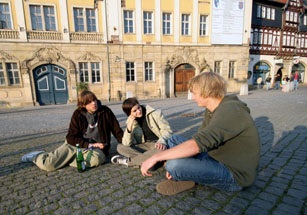
ECLA’s weekend trip started with a visit to Wartburg Castle in Eisenach, founded in 1067 by Count Louis the Jumper. One of the most memorable experiences here was to see the room where Martin Luther translated the New Testament from the original Greek texts into German in only ten months. The second stop was the Bachhaus, the first museum worldwide dedicated to Johann Sebastian Bach. The guided tour coupled with the live performance on historical instruments was a real treat. Saturday evening was a time for sharing impressions and musical improvisations at the youth hostel.
On Sunday, students and faculty left the hostel peacefully wrapped in the early morning fog, which slowly melted in the sunrays. A walk in the footsteps of Martin Luther, a gulp of fresh air, a batch of spectacular fly agaric mushrooms were some of the memorable moments. Later we had some time to stroll in the town of Weimar, which in fact could be described as a ‘culture rush’. There was a lot to do, and some of the students decided to start with the museum of Friedrich Schiller, Schillerhaus. Schiller acquired the building in 1802 and lived there with his family until his death in 1805. It seems as if life for Schiller was not so easy, as it was for Goethe, as far as financial matters are concerned. Most of Schiller’s manuscripts on exhibit are letters where he talks about his house and scraps of paper with calculations of the allocated amounts for items such as clothing, kitchen, house, etc. Some of his childhood drawings are on exhibit too: a colored pencil drawing of his father and a horse. The reproduction of ‘The Departure of Hector’ drawing from the second half of the 18th century hangs on the wall, which reminded some students of The Iliad, the first book on the AY curriculum. It is the scene where Hector has taken his helmet off in order not to frighten the baby with Andromache and the caretaker on each side.
Another visit was to Bauhaus with Laura as a guide. She explained that the goal for Bauhaus was to return to the essence of the object, which in the case of the table lamp in the shape of a bulb, a favorite of many, was the bulb itself. Next was the visit to Goethehaus, which is pretty much the same as it was in Goethe’s time, even though it’s hard to believe he had special rooms for exhibiting his collections consisting of busts, sculptures, minerals, plates, etc. The clock, which was too high to fit in the house, was made to fit in by carving the ceiling a little. The stairs are strikingly low because Goethe was hospitable and wanted to welcome his guests in a smooth manner, even at the stairway. It was interesting to hear that as Goethe was writing Faust he often put it aside and it was always Schiller who pushed him to finish it. They were colleagues and good friends at the same time. Goethe would provide Schiller with the regional information required for his books, which were often placed in settings he himself had never been.
Finally, the visit to Franz Liszt Haus impressed everyone with its homelike atmosphere and its original grand piano in the middle of the spacious yet comfortable room. Getting back on the bus, many were still thinking about the astonishing fact that all these outstanding writers, composers and artists lived just ‘around the corner’ from each other.
By Ayse Pinar Koprucu (AY 2005-2006, Turkey)
